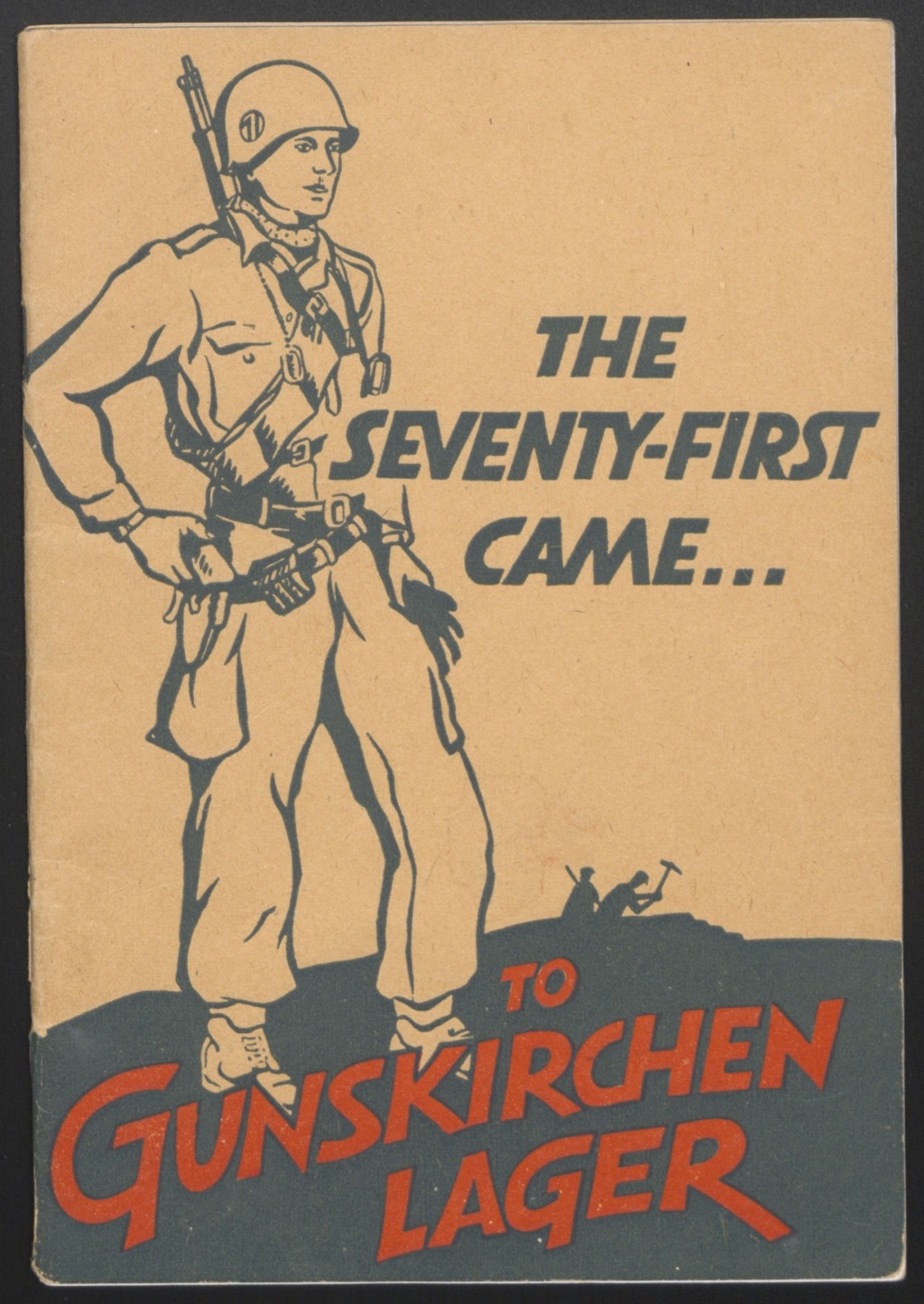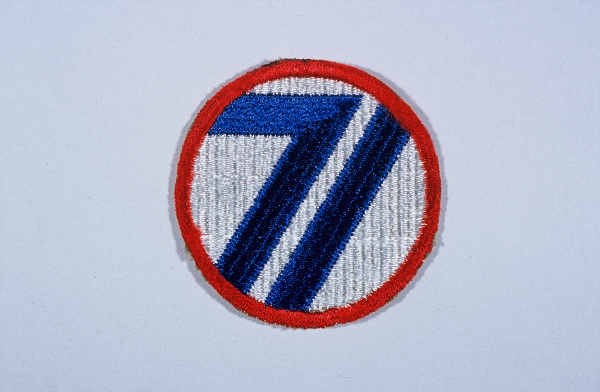
The 71st Infantry Division during World War II
In 1985, the United States Holocaust Memorial Museum and the US Army Center of Military History began a program to honor US Army divisions that took part in the Allied liberation of Nazi camps. The US Army Center of Military History defines a liberating division as one whose official records show its presence at a camp within 48 hours of the first soldier’s arrival. The 71st Infantry Division is among the 36 US divisions that have been recognized to date.
Key Facts
-
1
US, British, Soviet, and Canadian troops encountered concentration camps and other sites of Nazi crimes as they advanced across Europe in 1944 and 1945.
-
2
The Allied soldiers liberated sick and starving camp prisoners from Nazi tyranny. They also provided them with food, clothing, and medical aid.
-
3
The United States Holocaust Memorial Museum and the US Army Center of Military History have recognized 36 US divisions for their role in the liberation of Nazi camps.
71st Infantry Division Campaigns during World War II
The 71st Infantry Division (nicknamed the “Red Circle”) was created in August 1943. It landed in the French city of Le Havre in February 1945 and then advanced to Alsace-Lorraine. It crossed the Siegfried Line and the Rhine River into Germany in March 1945. After driving south throughout April, the 71st captured the cities of Coburg, Bayreuth, and Regensburg. When the war in Europe ended on May 8, 1945, the 71st Infantry Division was in the Austrian city of Steyr. There, it accepted the surrender of more than 100,000 German and Hungarian troops.
The 71st Infantry Division and the Liberation of Gunskirchen Subcamp
In early May 1945, the 71st Infantry Division liberated Gunskirchen. Gunskirchen was one of the many subcamps of the Mauthausen concentration camp. Mauthausen was near the Austrian city of Linz. Mauthausen’s subcamps were mostly located in the surrounding area. The Gunskirchen subcamp was approximately 27 miles southwest of the main camp in a forest just outside the town of Gunskirchen.
American soldiers found about 15,000 prisoners in a desperate condition at the Gunskirchen subcamp. The camp, which had been built in late 1944/early 1945, was vastly overcrowded. The original purpose of Gunskirchen is unclear. In late spring 1945, it served as a reception camp for prisoners evacuated from other sites by train or on foot. Most of the prisoners were Hungarian Jews, who had been forced to perform hard manual labor near the Austro-Hungarian border. Some of these prisoners came to Gunskirchen by way of the Mauthausen main camp. Others had likely been sent directly to Gunskirchen. The Gunskirchen camp had just six barracks and limited sanitary facilities.
In these dire conditions, diseases such as typhus and dysentery spread rapidly through the starving and weakened camp population. Thousands died as a result.
In the months after liberation, more than 1,000 former prisoners died as a result of their mistreatment by the Nazis.
After the war, the 71st Infantry Division administered 23 displaced persons (DP) camps. It provided aid to Holocaust survivors, former forced laborers, and other refugees.
US Soldiers’ Recollections of Liberating Gunskirchen
Shortly after liberating Gunskirchen, the 71st Infantry Division published a short pamphlet about what it had discovered there. The booklet was to serve as a “permanent, honest record of the crimes committed there …” It was a collection of US soldiers’ accounts of what they had experienced and witnessed upon liberating the subcamp.

Captain J. D. Pletcher, from the headquarters of the 71st Infantry Division, recounted his first impressions of Gunskirchen on the day it was liberated:
As we entered the camp, the living skeletons still able to walk crowded around us and, though we wanted to drive farther into the place, the milling, pressing crowd wouldn't let us. It is not an exaggeration to say that almost every inmate was insane with hunger. Just the sight of an American brought cheers, groans and shrieks. People crowded around to touch an American, to touch the jeep, to kiss our arms—perhaps just to make sure that it was true. The people who couldn't walk crawled out toward our jeep. Those who couldn't even crawl propped themselves up on an elbow, and somehow, through all their pain and suffering, revealed through their eyes the gratitude, the joy they felt at the arrival of Americans.
One English-speaking prisoner informed Pletcher that for days, “the inmates had lived on faith alone … Faith that the Americans would come soon.”
After entering the camp, the 71st began requisitioning supplies and transportation from the local town to provide the prisoners with food and water. The US troops ordered German prisoners of war to load ill and wounded concentration camp inmates onto trucks for transport to local hospitals. Other captured German soldiers were forced to give a proper burial to the many dead prisoners in Gunskirchen.
What the American soldiers saw in the camp caused them to reflect upon their wartime experiences. Pletcher stated:
I felt, the day I saw Gunskirchen Lager, that I finally knew what I was fighting for, what the war was all about.
Corporal Jerry Tax also recorded the powerful impressions the newly-liberated prisoners made on him:
And in their eyes, you read the story of the past four or five years. You didn’t have to look at that one’s back to see the scars where the whip had dug deep; the scars were in his eyes. Would they ever leave them?
Recognition as a Liberating Division
The 71st Infantry Division was recognized as a liberating unit by the US Army's Center of Military History and the United States Holocaust Memorial Museum in 1988.
71st Infantry Division Battle Casualty Figures
Hundreds of thousands of US servicemen and women died or were wounded in the fight against Nazi tyranny.
The total number of battle casualties for the 71st Infantry Division in the European Theater of Operations during World War II was 1,114. In this case, “battle casualties” includes all personnel who were unable to fight in battle because they were wounded, missing, captured, or killed.
There were 279 deaths among the battle casualties suffered by the 71st Infantry Division.
71st Infantry Division Nickname and Insignia

The nickname of the 71st Infantry Division is the “Red Circle” division. This nickname is based on the shape and color of the divisional insignia or patch: a circle with a red border. Inside the circle is the number “71” in blue on a white background.
Footnotes
-
Footnote reference1.
The Seventy-First Came ... to Gunskirchen Lager (Augsburg: E. Kieser KG., Druckerei u. Verlag, 1945), 3.
-
Footnote reference2.
The Seventy-First Came, 5.
-
Footnote reference3.
The Seventy-First Came, 6.
-
Footnote reference4.
The Seventy-First Came, 11.
-
Footnote reference5.
The Seventy-First Came, 26.
-
Footnote reference6.
In the aftermath of World War II, the US Department of the Army compiled casualty figures for US Army personnel. The US government published these figures in 1953. The report listed casualty numbers for the US Army for the period from December 7, 1941 (Pearl Harbor) through December 31, 1946, when US President Harry S. Truman officially declared the end of war hostilities. Army Battle Casualties and Nonbattle Deaths: Final Report, 7 December 1941-31 December 1946, Prepared by the Statistical and Accounting Branch, Office of the Adjutant General, Under the Direction of the Program Review and Analysis, Division of the Comptroller of the Army, O.C.S., (Washington: Department of the Army, 1953), p. 3-4, 84-89.
Critical Thinking Questions
What challenges did Allied forces face when they encountered the camps and sites of other atrocities?
What challenges faced survivors of the Holocaust upon liberation?

